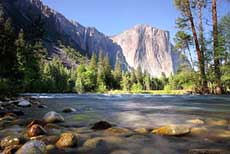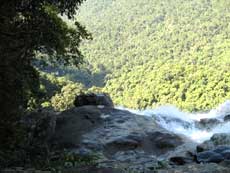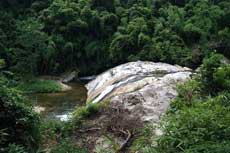The nation parks of Phu Quoc, Tam Dao and Bach Ma are listed as the wildest places in Vietnam.
Phu Quoc National Park
 The park is situated in the North-East of Phu Quoc Island in the southern province of Kien Giang and has boundaries with the coastline. It has become an ideal eco-tourist destination.
The park is situated in the North-East of Phu Quoc Island in the southern province of Kien Giang and has boundaries with the coastline. It has become an ideal eco-tourist destination.
Phu Quoc National Park has special and unique biodiversity values compared to other national parks across the country.
Located on an island that has a mixture of continental and coastal climate, the park possesses a rich ecosystem of primeval, secondary and indigo forests. Its indigo forests are distributed in the wetlands or the lowlands that is flooded in the rainy season and sloping hills.
The topography of the national park is hilly, although not particularly steep with the highest point is Mount Chua, at 603 m. Being drained by numerous, mainly seasonal, streams, the only sizeable river on the island is the Rach Cua Can River, which drains the southern part of the national park, and flows into the sea on the west coast of the island.
Phu Quoc National Park is the ideal environment for more than 470 species of plants and several types of coral reefs offshore. Phu Quoc Island is lowland evergreen forest and the national park supports 12,794 ha of forest, equivalent to 86% of the total area. To date, 929 plant species have been recorded on Phu Quoc Island. At lower elevations in some areas, the national park supports distinctive formations of Melaleuca - one kind of trees that the leaves are evergreen, alternately arranged, dark green and grey-green in color.
As regards to the fauna system, a list of 43 mammal species belonging to 18 families and 6 orders was compiled in here. Silvered langur, slow loris, pygmy loris, crab-eating macaque, stump-tailed macaque, small-clawed otter and fruit bats are species of the most conservation concern.
Due to the extremely plentiful coral reefs in the south of the island, there are 125 species of fish, 132 species of mollusk and 62 species of sea weed. Interestingly enough, Phu Quoc is also one of the two places in Vietnam where the Dugong, a marine species on the brink of extinction can be found.
Phu Quoc National Park proves it to be a destination for tourists as it offers a wide range of activities such as camping and trekking. It is also ideal for those who want to study the tropical forest.
Bach Ma National Park
 Bach Ma National Park is situated within Phu Loc and Nam Dong districts of the central province of Thua Thien - Hue, about 60km to the south of Hue city (and about 680km from Hanoi). It is well-known for the wonderful natural landscape as well as the fresh atmosphere.
Bach Ma National Park is situated within Phu Loc and Nam Dong districts of the central province of Thua Thien - Hue, about 60km to the south of Hue city (and about 680km from Hanoi). It is well-known for the wonderful natural landscape as well as the fresh atmosphere.
The park was established in 1991 with the total area of 22.031 hectares and was expanded larger in 2008 in order to better protect the ecological system. Bach Ma was recognized as one of the biodiversity centers of Indochina for its ecological diversification.
Its climate condition is somehow the same as those in Da Lat, Sapa, Tam Dao. However, due to its location (which is near the sea), the temperature here is seldom under 4oC in winter and above 26oC in summer. The favorable climate conditions have brought about great potentials for Bach Ma to develop tourism as well as preserve natural flora and fauna system.
Bach Ma peak lies at 1.450 meters high and is covered by clouds all year round. From Hue city, drive 40 km south along the 1A Highway to Cau hai town, then turn right and continue to drive for 19 km, you will reach Bach Ma National Park. Upon reaching the highest peak, tourists will have a breathtaking view over the continuous mountain ranges and steep peaks.
Bach Ma National Park still preserves its entire diversified flora system and spreading primitive forest. In the forest, there exist many precious types of trees, among which there are trees with diameter of 80-100 cm.
The flora system there comprises up to 1.406 species, all of which are being well-preserved. Bach Ma’s fauna system comprises 931 species including 83 species of animals, 333 species of birds, 31 species of reptiles, 39 species of fishes, and many species of butterflies, insects, ants, etc.
With beautiful natural scenery plus the fresh and cool climate, Bach Ma national park can be regarded as the most precious ecological tourism center in the region.
Tourists visiting Bach Ma will have chance to explore the mysterious tourist paths such as the Tri Sao (Star marisca) path, Do Quyen (water-rail) path, Ngu Ho (Five-lakes) path, Hai Vong Dai path.
Tourists can also observe the collapsed buildings, which were once constructed under the French colonial period, on the peak and surrounding mountain sides. It is the vestiges of the palace and hotel area which was constructed in 1932 by a French engineer, M. Girard, with the purpose of transforming the area into a resort. Two ancient villas was recovered and functioned as the research centers as well as the accommodation for visitors.
Tam Dao National Park
 Tam Dao, located about 70km north of Hanoi, was recognized as a National Park in March 1996. With a total area of about 36,900ha, Tam Dao is one of the largest national parks in Vietnam and one of the last natural areas close to urban Hanoi which has not been transformed into agricultural land.
Tam Dao, located about 70km north of Hanoi, was recognized as a National Park in March 1996. With a total area of about 36,900ha, Tam Dao is one of the largest national parks in Vietnam and one of the last natural areas close to urban Hanoi which has not been transformed into agricultural land.
Tam Dao is in a vast high mountainous region affected by tropical humid monsoons. The average temperature during the year is 22.9 C. It is ideal to visit in the summer and enjoy the fresh, pure and cooling air, beautiful scenery.
There are two tourist sites in the park. The first is Tam Dao town which was established in the beginning of the 20th century. Tam Dao is nestled in a valley covering only 3 km2. There now remain some villas and palaces built by French colonists. It has Thac Bac (Silver Fall), Rung Rinh peak and Tam Dao Nr. 2, a remnant of another resort built many years ago.
The second tourist location is Tay Thien site. It includes Tay Thien Quoc Mau Temple (literally the "Temple of East Heaven National Mother") and several pagodas. Along with Thien Vien Truc Lam in Dalat and Yen Tu, Truc Lam Tay Thien Zen Monastery here is a center of Vietnamese Buddhism. The area is rich in biodiversity and is home to species found in other ecosystems in the region, ranging from the rain forests of South-East Asia to the alpine forests of the eastern Himalaya.
The park has a forest of Do Quyen trees (Rhododendron simii) that blossom in spring, limpid Xa Huong Lake, Silver Waterfall in the middle of evergreen forests all the year round.
Tam Dao National Park is covered by a rich flora, consisting of 490 species from 34 genera and 130 families (64 of which are listed in Vietnam Red book of endangered species).
There is a great deal of rare plants, such as Sam bong, Permu (fokienia hodginsir), Kim Giao (polo carpus fleuryi), Lat Hoa (chukrasta tabularies), Thong Tre (Podocarpus nerliforlius), Sen Mat (Madhuca pasquieri).
Tam Dao National Park is also home to 281 species of fauna from 281 genera, 84 families and 26 orders belonging to 4 main classes of animals, birds, reptiles and amphibious ones. Among the variety of life forms in the park are several rare species (56 of which are registered in Vietnam's Red Book) including cheek black monkey, Tam Dao snake-head fish, silver pheasant wood grouse etc.